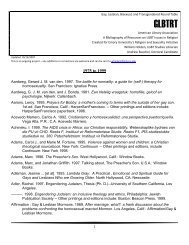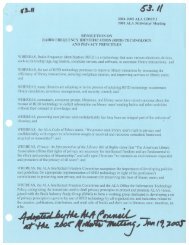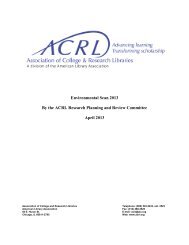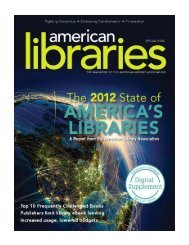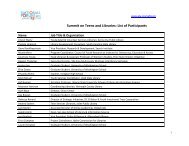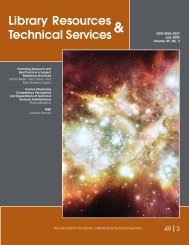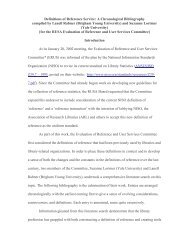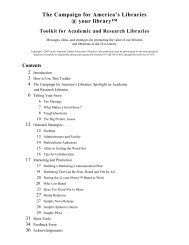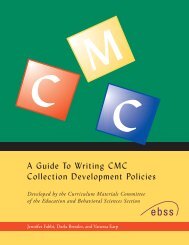Toolkit for School Library Media Programs - American Library ...
Toolkit for School Library Media Programs - American Library ...
Toolkit for School Library Media Programs - American Library ...
Create successful ePaper yourself
Turn your PDF publications into a flip-book with our unique Google optimized e-Paper software.
Marketing to All<br />
Libraries are places where students can learn about<br />
people who are both similar to and different from<br />
themselves. They should also be places where students’<br />
differences are acknowledged and respected. In<br />
marketing your school library media program, you will<br />
want to address a wide range of differences stemming<br />
from physical, mental or emotional abilities, language,<br />
racial, socioeconomic or cultural background.<br />
For more in<strong>for</strong>mation, see:<br />
Against Borders Promoting Books <strong>for</strong> a Multicultural<br />
World by Hazel Rochman, ALA Editions, 1993.<br />
Cultural Diversity in Libraries by Donald E. Riggs and<br />
Patricia A. Tarin, Neal-Schuman Publishers, 1994<br />
Cultural Diversity and Gender Equity, an extensive<br />
curriculum resource list from the Otto-Blair Middle<br />
<strong>School</strong>, Blair, NE. www.esu3.org/districts/Blair/OBMS/<br />
curriculum/social_studies/culture_gender.html.<br />
Equal Access to Software and In<strong>for</strong>mation (EASI),<br />
Training on barrier-free Web design and other matters.<br />
www.rit.edu/~easi<br />
Designing a More Usable World—<strong>for</strong> All, Trace Research<br />
& Development Center, University of Wisconsin, College<br />
of Engineering. A guide to products, technologies,<br />
training and techniques to eliminate barriers and create<br />
expanded opportunities. www.trace.wisc.edu<br />
ERIC Clearinghouse on Counseling and Student<br />
Services. Highlights articles, resources and research on<br />
serving culturally diverse students from elementary<br />
through college level. http://ericcass.uncg.edu/virtuallib/<br />
diversity/diversitybook.htmlER<br />
LD Online, the leading Web site on learning disabilities <strong>for</strong><br />
parents, teachers and other professionals.<br />
www.ldonline.org<br />
“Tech <strong>for</strong> Kids With Disabilities” by Harriet Selverstone,<br />
<strong>School</strong> <strong>Library</strong> Journal, June 2003, p. 36.<br />
U.S. Department of Justice Web site. For in<strong>for</strong>mation<br />
about federal laws and resources, see the page on<br />
disabilities at www.usdoj.gov/disabilities.htm.<br />
Venture into Cultures, Second Edition, A Resource Book<br />
of Multicultural materials and <strong>Programs</strong>, Olga R.<br />
Kuharets, Ethnic and Multicultural Exchange Round Table<br />
(EMIERT), ALA Editions, 2001.<br />
18<br />
Communicating a warm welcome is especially important<br />
<strong>for</strong> children and parents who may have had little<br />
experience with libraries. This includes a com<strong>for</strong>table<br />
physicial environment, collections that help students<br />
learn about their differences, and staff who are sensitive<br />
to these differences. Working to develop projects that<br />
celebrate the spectrum of humanity communicates that<br />
the media center is central to teaching and learning<br />
about diversity in all <strong>for</strong>ms.<br />
Reaching Out to Children with<br />
Disabilities<br />
Today there are many new and increasingly af<strong>for</strong>dable<br />
assistive technologies that can help to ensure all students<br />
become successful seekers and users of in<strong>for</strong>mation.<br />
Susan Gilbert Beck, president of Emanda, Inc. and a<br />
consultant on library access, offers the following<br />
guidelines.<br />
● Be sensitive in your use of language, both when<br />
speaking and in developing signage, publications<br />
and other materials. A child is far from being totally<br />
described by a disability.<br />
● Assess your media center’s traffic patterns and use of<br />
space to ensure there is adequate access <strong>for</strong> wheel<br />
chairs.<br />
● Make sure your Web page is friendly to users of<br />
various physical and mental abilities. You can gauge<br />
its accessibility at http://bobby.watchfire.com/bobby/<br />
html/en/index.jsp. You also will find guidelines <strong>for</strong><br />
using screen readers like JAWS, the Kurzweil print<br />
reader and other assistive technologies that enhance<br />
readability <strong>for</strong> people with vision difficulties.<br />
● Assess the availability of on-site assistive and<br />
adaptive software and equipment and make<br />
improvements if necessary.<br />
● Offer awareness training to the library (and school)<br />
staff. If communication seems to be a problem,<br />
consider what solutions might be reasonable and<br />
considerate. Staff should know proper approaches to<br />
promoting library programs to children with<br />
deafness, blindness, mental illness, learning and<br />
other disabilities and helping them to participate.<br />
● Join an electronic discussion list that addresses<br />
libraries and disability access. To subscribe, send an<br />
e-mail to listserv@maelstrom.stjohns.edu. In the body<br />
of the message, type: subscribe axslib-l [your first<br />
and last name].



